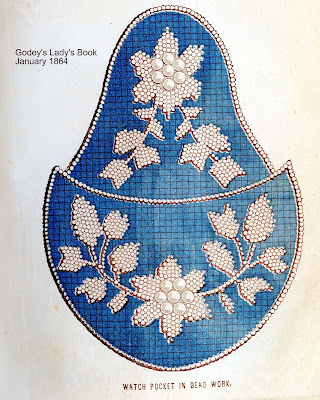By Karen Osburn, Archivist
Many
of my friends are artists and “crafters”, people who create beautiful jewelry,
furniture, clothing, housewares, musical instruments and more with their hands. Through knowing these talented folks a bit of
their interests have rubbed off on me and over the years I have tried my hand
at a wide variety of crafts including macramé, embroidery, crochet, sketching,
sewing and beadwork to name a few. I
find learning new crafts exciting and fun.
Apparently so did women in the 19th century.
In
the Historical Society Library and Archives we have copies of Godey’s Lady’s Book and Magazine dating
from 1858 to 1870 and Peterson’s
magazine from 1863 to 1877. They show
many examples of handwork for women. Godey’s
had a section called “Work Department” and other areas called Novelties,
Embroidery and Fashions. Each of these
sections of the magazine had ideas, patterns or suggestions of items to be
stitched, altered, crocheted, tatted, embroidered or created by hand. The archive also has a copy of Catharine E.
Beecher and Harriet Beecher Stowe’s The
American Woman’s Home which devotes an entire chapter to “Home
Decoration”. Many of the projects in
these publications are suggested as a way to make something useful expending as
little money as possible. This seems to
have been a common thread in many ladies publications of the 19th
Century.
It
appears that in the past, women of financially stable families were encouraged
to do handwork. In the Historical
Society collection we have several samplers by different individuals testifying
to proficiency with a needle. Information
gathered from Geneva Geneva
Academy
Some
of the items promoted in magazines were as fun and interesting to create then as
it now. In the Godey’s Ladies book of February 1864, vol. LXVIII there is a
pattern for a beaded watch pocket. I had
the privilege of working with Native American beadwork collections housed at
the Rochester Museum
& Science Center
and the Royal Ontario
Museum in Toronto
What
types of items did women create in the 1800s?
We have examples of clothing, embroidery, samplers, feather wreathes,
hair jewelry, and hand painted items in the Geneva Historical Society
collection. Some crafts like drawing,
painting and crochet continue to be of interest through time. Other ideas, such as hair wreaths, are seldom
created anymore.
All
the women I grew up with did handwork.
My grandmother was capable of looking at a crocheted doily on a
neighbor’s table and reproducing it without instructions. She also did embroidery that was just
beautiful. My mother was a very capable sketch artist as well as good at sewing
clothes, embroidery, wood carving and crochet.
My sister is good at all those things plus makes incredibly decorated
walking sticks. I also have male friends
who have made musical instruments, their own chainmail shirts, carved with
chain saws, and made furniture. Crafts
and art are an equal opportunity form of expression.
Perhaps
you have a favorite hobby? You may want
to look in old books and magazines to find new/old patterns to embroider or
crochet; new techniques to try with painting or even a new/old hobby such as
stenciling. There are many satisfying
and intriguing historic crafts just waiting to be rediscovered. I hope this piques your interest enough to
investigate your talents.



Did you know that you can earn money by locking selected areas of your blog / website?
ReplyDeleteSimply open an account on AdscendMedia and run their content locking tool.